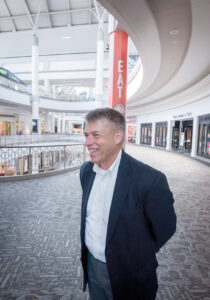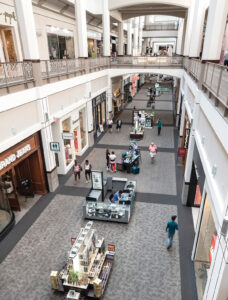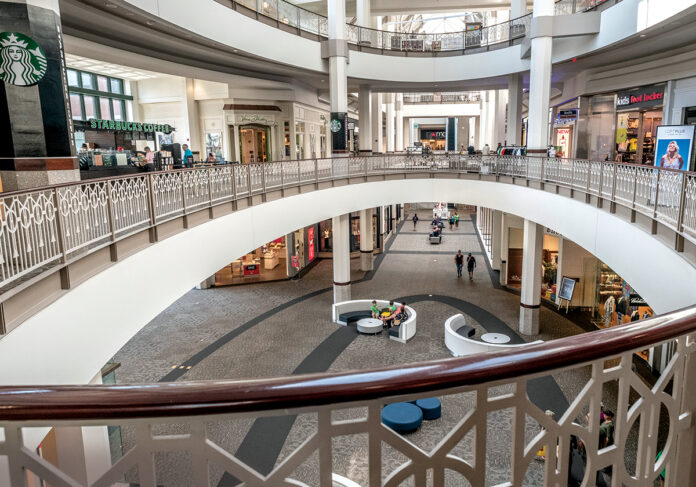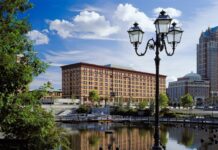To many, the closure of Nordstrom at Providence Place mall was a disheartening blow for the capital city, and further proof online shopping is sapping the life out of brick-and-mortar retailers and the malls in which many are located.
To Mark Dunbar, it was just another day at the office.
See related story: An outlier comes to Providence Place
As Providence Place’s general manager, Dunbar has been at the helm of the urban mall for more than eight years, during some of the most turbulent times for the retail industry in recent memory. He’s also endured an ownership shakeup, remaining on board when Providence Place owner GGP Inc. was taken over by Brookfield Property Partners LP last year.
If he was rattled by Nordstrom’s departure in January, Dunbar is not showing it now.
“Most people look at this as a negative,” he said as he strolled through the mall recently. “But things change. We lose stores. It’s actually a strength because we evolve.”
He has a point, retail specialists say.
To compete with the convenience of shopping on the web, mall owners have no choice but to evolve, they say, to reposition their properties and shift focus on more experience-oriented activities. The goal: becoming a social and cultural hub instead of just a shopping center.
“Consumers still want to go to a mall, but they want to have more than clothing there,” said Kristen Regine, a Johnson & Wales University marketing professor who specializes in consumer behavior and retail trends. “Malls have to give us a compelling reason to go.”
So how is Providence Place doing in its evolution? In the short-term, the answer may depend on how well incoming anchor Boscov’s does.
The family-owned department store, based in Pennsylvania, is moving into Nordstrom’s anchor spot at the north end of the mall, taking up all three levels. The store is slated to open at the end of September. That’s a better outcome than when J.C. Penney left in 2015, and the mall failed to attract a replacement. Much of that space has been converted to parking.
Being the first Boscov’s in the region works in the mall’s favor, according to Regine.
“It’s something new, which is going to create curiosity,” she said. “People are going to want to check it out. But the key is not to disappoint them.”
[caption id="attachment_290337" align="alignright" width="210"]

GROWING TREND: Mark Dunbar, Providence Place mall general manager, said beginning with an online presence and expanding into physical locations is a growing trend among retailers.
/ PBN FILE PHOTO/MICHAEL SALERNO[/caption]
Dunbar is optimistic, despite grumbling in some circles that Providence Place has lost a high-end retail anchor and gained a middling one.
“As people come here to shop for the holidays, they’re going to experience Boscov’s,” he said. “Give them some time so they get to know what the offerings are and what Boscov’s is. I think it’s going to be very successful.”
In the meantime, Providence Place is holding its key metrics close to the vest.
Dunbar insists Providence Place has plenty of foot traffic, which he says is among the most visited malls in Brookfield’s portfolio of more than 160 retail properties. He declined to provide details.
A financial statement from the mall made public in June 2018 on a municipal bond website indicated that sales across the total Providence Place property were $332 per square foot for 2017, below the $400 marker considered about average for shopping malls.
Dunbar wouldn’t reveal what those sales numbers are now, saying that information is proprietary. Likewise, he wouldn’t reveal the vacancy rate at the mall, either. That same December 2017 financial statement said the vacancy rate was 7.6% at the end of 2017. At the time, mall vacancy rates averaged 8.3% nationally, according to Reis Inc., a real estate research firm.
Neil Amper, vice president at Capstone Properties, a Massachusetts-based real estate brokerage and management firm with a regional office in Providence, likes what he sees at the mall.
Yes, the loss of Nordstrom hurt. “Women are still lamenting that,” Amper said. But a midrange department store such as Boscov’s “might do OK around here.” The Apple store is always a big draw, he added, “and the rest of the tenants in there seem to be doing OK.”
Things have changed quite a bit since 1.2 million-square-foot Providence Place opened 20 years ago with upscale stores such as Williams-Sonoma, Pottery Barn, Crate & Barrel, Restoration Hardware, as well as Nordstrom.
Since then, seismic shifts in retail brought about by the likes of Amazon.com Inc. have rocked Providence Place and other malls, as customers have flocked to their computer screens and smartphones to do their shopping.
At the same time, competition has stiffened among regional shopping centers looking to attract upscale retailers.
Regine ticked off numerous top-end retail centers less than 40 minutes from downtown Providence, including Legacy Place, Natick Mall and University Station in Massachusetts, and Garden City in Cranston.
Both Regine and Amper had high praise for Garden City, saying its owner, the Wilder Cos., has found a strong mix of eateries and retail stores, and amenities such as L.A. Fitness. “With the housing around there, it has almost become a lifestyle area,” Amper said.
As Garden City’s desirability has increased in recent years, stores such as Williams-Sonoma, Pottery Barn and Crate & Barrel have pulled out of Providence Place and moved to Cranston.
To Regine, those departures are an indication that Providence Place has stumbled a bit.
Beyond Dave & Buster’s restaurant and video arcade, the 16-screen cinema and IMAX theater, “what else do you have to get people out and about?” she said. “You got to have things that connect people, like Garden City has done” with events such as its summer concert series.
Dunbar takes the mall’s unsettled future in stride.
“The only thing you can count on in retail is change,” he said. “Evolution is what we’re about. It’s about bringing in the next stores and making sure they’re the kind of stores your customer is looking for.”
[caption id="attachment_290338" align="alignleft" width="228"]

SALES: The Providence Place mall had sales of $332 per square foot in 2017, according to a financial statement from the mall made public in June 2018 on a municipal bond website. The figure is below the $400 marker considered average for shopping malls.
/ PBN PHOTO/MICHAEL SALERNO[/caption]
He pointed to luxury jeweler Tiffany & Co., and apparel stores Michael Kors, Free People, Brooks Brothers and The North Face among the retailers whose only location in the area is at Providence Place.
Dunbar noted how one of Providence Place’s newest tenants, Adore Me, a women’s intimates company based in New York City, started as an e-retailer but has branched into physical locations. That business strategy is a growing trend, Dunbar said.
Providence Place’s addition of a cycling studio called CycleBar in a street-level storefront two years ago is another sign of things to come, Dunbar added. The mall also rents 4,500 square feet to the Comprehensive Community Action Program for a “skills center” that offers computing and language classes and other job-training workshops.
“We’re not just selling socks anymore,” Dunbar said. “We’re selling experience. We’re selling the environment.”
The “lifestyle center” concept has been successful at other shopping developments across the country. Could we see a proposal for condos or apartments at Providence Place?
“The changes you’re going to see in places like this over the next 10 years, you might see something like that come into play,” Dunbar said.
William Hamilton is special projects editor at PBN. Contact him at Hamilton@PBN.com.














